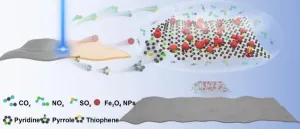(Press-News.org) COLUMBUS, Ohio - A new $3.9 million grant from the U.S. Food and Drug Administration (FDA) will allow researchers with the Center for Tobacco Research at The Ohio State University Comprehensive Cancer Center to evaluate effects of e-cigarette flavors on the smoking behaviors of current adult smokers.
The study, co-led by Theodore Wagener, PhD, director of Ohio State’s Center for Tobacco Research, and Tracy Smith, PhD, of the Medical University of South Carolina (MUSC) Hollings Cancer Center, will be the first to provide definitive information about the impact of non-tobacco e-cigarette flavors for helping adult smokers stop smoking.
Wagener says this study will provide scientific data that are urgently needed to inform the FDA’s regulation of flavor use in e-cigarettes.
Youth advocates have strenuously objected to flavored e-cigarettes, arguing that, with flavors like cinnamon bun, cotton candy, bubble gum, mango, strawberry or chocolate, e-cigarettes are enticing young people to take up an addictive and harmful habit. Those flavors might also be more appealing to adults who smoke cigarettes and have been unable to quit.
“The FDA is currently making regulatory decisions about e-cigarette flavors with incomplete scientific data. Existing data show that smokers also prefer flavored e-cigarettes, and while there are a few survey studies suggesting that flavored e-cigarettes may be more helpful for switching to vaping, these studies are not rigorous enough for the FDA to base its regulatory decisions on. Our study will be the first to provide the FDA with definitive information as to the benefit, if any, of e-cigarette flavors to adult smokers,” Wagener said.
While the National Academies of Science, Engineering and Medicine have concluded that e-cigarettes are likely to be far less harmful than combustible cigarettes, Wagener notes that more than 1 million e-cigarette products have been banned since 2020, mostly due to the significant rise in youth vaping, often with flavored e-cigarettes.
Switching to e-cigarettes, while not a completely healthy choice, is thought to be better than continuing to smoke, a concept that public health scientists refer to as “harm reduction.”
Wagener says “the FDA must decide how to balance its goals of protecting young people and offering harm-reduction options to adults. This new trial will generate critical data to help make more informed public health decisions that have a lasting impact.”.
New study evaluates how much flavoring impacts smoking behavior
This national, randomized, controlled trial will recruit up to 1,500 cigarette users from the across the United States.
Researchers will measure e-cigarette flavor impact on product uptake and appeal, cigarette craving, symptoms, dependence and smoking behavior, including sustained and complete switching from cigarettes to e-cigarettes. They will also utilize combination nicotine replacement therapy (NRT, patch and lozenge) as an FDA-approved comparator to determine the potential increased benefit (or not) of e-cigarettes versus nicotine replacement therapies on smoking. Smokers will be randomized to one of three groups: preferred flavor e-cigarette, tobacco flavor e-cigarette or combination nicotine replacement therapy.
Study participants will receive products at no cost for 14 weeks. Participants in the preferred flavor group will be able to change flavors throughout that time. Changes in smoking will be biochemically confirmed via remote exhaled carbon monoxide readings at 12 weeks and 26 weeks after the product switch date.
“If our study demonstrates no significant improvements in switching with flavored e-cigarette use, then the continued sale of these products is likely indefensible; however, if improvements are significant, these findings will provide a critical counterweight to the current FDA regulations and will aid future decision making,” Wagener said.
To learn more about tobacco research at Ohio State, visit cancer.osu.edu/CTR or call 1-800-293-5066.
###
END
$3.9M grant funds e-cigarette flavoring research at Ohio State’s Center for Tobacco Research
2023-07-12
ELSE PRESS RELEASES FROM THIS DATE:
Gut bacteria linked to fatty deposits in heart arteries
2023-07-12
In a major Swedish study, researchers have discovered a link between the levels of certain bacteria living in the gut and coronary atherosclerotic plaques. Such atherosclerotic plaques, which are formed by the build-up of fatty and cholesterol deposits, constitute a major cause of heart attacks. The study was led by researchers at Uppsala and Lund University and the findings have now been published in the scientific journal Circulation.
The new study was based on analyses of gut bacteria and cardiac imaging among 8,973 participants aged 50 to 65 from Uppsala and Malmö without previously known heart disease. They were all ...
Study reveals new mechanism for rapid evolution of multi-drug resistant infections in patients
2023-07-12
Findings challenge the traditional view that antimicrobial resistance (AMR) emerges from pathogens that acquire new mutations
Samples from ICU patients suggest that instead, highly diverse pathogen communities harbour pre-existing resistant genotypes
The results suggest that interventions aimed at limiting the spread of bacteria between patients may provide a powerful approach to combat AMR.
A research study led by the University of Oxford provides a transformational new insight into how antimicrobial resistance (AMR) emerges in patients with bacterial infections. The findings, published today in the journal ...
Blood pressure patterns in the first half of pregnancy improve early prediction of preeclampsia and gestational hypertension
2023-07-12
Routine blood pressure readings recorded in the first half of pregnancy can be divided into 6 distinct patterns that can effectively stratify patients by their risk of developing preeclampsia and gestational hypertension later in pregnancy, Kaiser Permanente researchers found.
The study, published July 12 in the Journal of the American Heart Association, showed that 6 pregnancy blood pressure trajectories seen within the first 20 weeks of pregnancy along with clinical, social, and behavioral risk factors can accurately predict and stratify risk of preeclampsia and gestational hypertension in low- to moderate-risk patients. ...
Gulf War illness caused by mitochondrial dysfunction, not inflammation
2023-07-12
Gulf War Illness (GWI) is a chronic multisymptom health condition affecting one-third of all veterans who served in the 1991 Gulf War, most of whom remain afflicted more than 30 years later. Common symptoms include fatigue, headaches, muscle aches, joint pain, diarrhea, insomnia and cognitive impairment.
The condition is believed to have been triggered by veterans’ exposure to environmental toxins. However, its exact mechanism in the body continues to be debated, making it difficult to diagnose and treat. The prevailing ...
Queen Mary-led research uncovers why people who have Down’s Syndrome age prematurely
2023-07-12
An overdosed gene on chromosome 21 causes people with Down’s Syndrome to age faster than the general population.
The molecular processes responsible for natural ageing of cells are poorly understood. Studying conditions in humans where ageing is accelerated due to genetic causes presents opportunities to learn about the mechanisms that control ageing and devise strategies to slow down the ageing process.
Adults who have Down’s Syndrome (DS) show earlier signs of ageing-related conditions: reduction in tissue regenerative capacity, alopecia, dry skin, ...
Scientists find evidence of world’s oldest glaciers
2023-07-12
Scientists have discovered the traces of the world’s oldest known glaciers, dating from 2.9 billion years ago, in rocks sitting under the world’s largest gold deposits in South Africa. This suggests the presence of continental ice caps at that time and that either the area was closer to the poles, or that parts of the Earth may have been frozen in a previously unknown “snowball Earth” period of extreme cold weather. This work is presented for the first time at the Goldschmidt geochemistry conference in Lyon, after recent peer-reviewed ...
Sea snakes may have evolved to see colors again
2023-07-12
A new paper in Genome Biology and Evolution, published by Oxford University Press, finds that the annulated sea snake, a species of venomous snake found in ocean waters around Australia and Asia, appears to have evolved to see an extended palette of colors after its ancestors lost that ability in response to changing environments.
Color vision in animals is primarily determined by genes called visual opsins. While there have been multiple losses of opsin genes during the evolution of tetrapods (the group including amphibians, reptiles, and mammals), the emergence of new opsin genes is extremely ...
Supercomputer used to simulate winds that cause clear air turbulence
2023-07-12
A research group from Nagoya University has accurately simulated air turbulence occurring on clear days around Tokyo using Japan’s fastest supercomputer. They then compared their findings with flight data to create a more accurate predictive model. The research was reported in the journal Geophysical Research Letters.
Although air turbulence is usually associated with bad weather, an airplane cabin can shake violently even on a sunny and cloudless day. Known as clear air turbulence (CAT), these turbulent ...
Sea snake vision evolved to regain color
2023-07-12
An international team of scientists examining the genetic history of sea snakes have found that the species has enhanced their colour vision in response to living in brighter and more colourful marine environments.
“Our research has found that the annulated sea snake possesses four intact copies of the opsin gene SWS1,” said PhD candidate Isaac Rossetto, from the University of Adelaide’s School of Biological Sciences who led the study.
“Two of these genes have the ancestral ultraviolet sensitivity, and two have evolved a new sensitivity to the longer wavelengths that dominate ocean habitats.
“The earliest ...
Scientists developed 180% relative bandwidth microwave absorber by ultrafast UV laser
2023-07-12
Scientists from Chinese Academy of Sciences Ningbo Institute of Materials Technology and Engineering, National Physical Laboratory (UK), The University of Manchester (UK) and National University of Singapore have developed a new approach, published in International Journal of Extreme Manufacturing (IF: 14.7), to fabricate a specifically designed wideband microwave absorption metamaterial with well-controlled electrical and magnetic characteristics on a polyethylene terephthalate (PET) substrate using ultraviolet (UV) laser irradiation.
The process involves using a UV laser to precisely control the characteristics of 2-D pattern on a specially formulated donor ...





